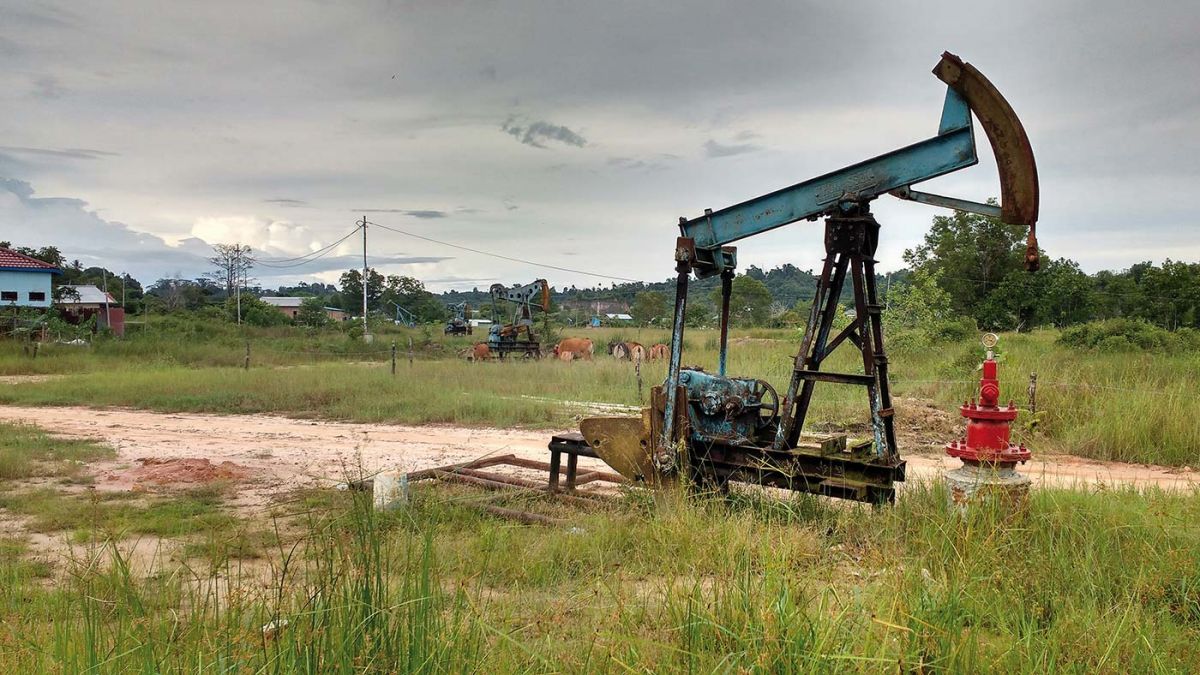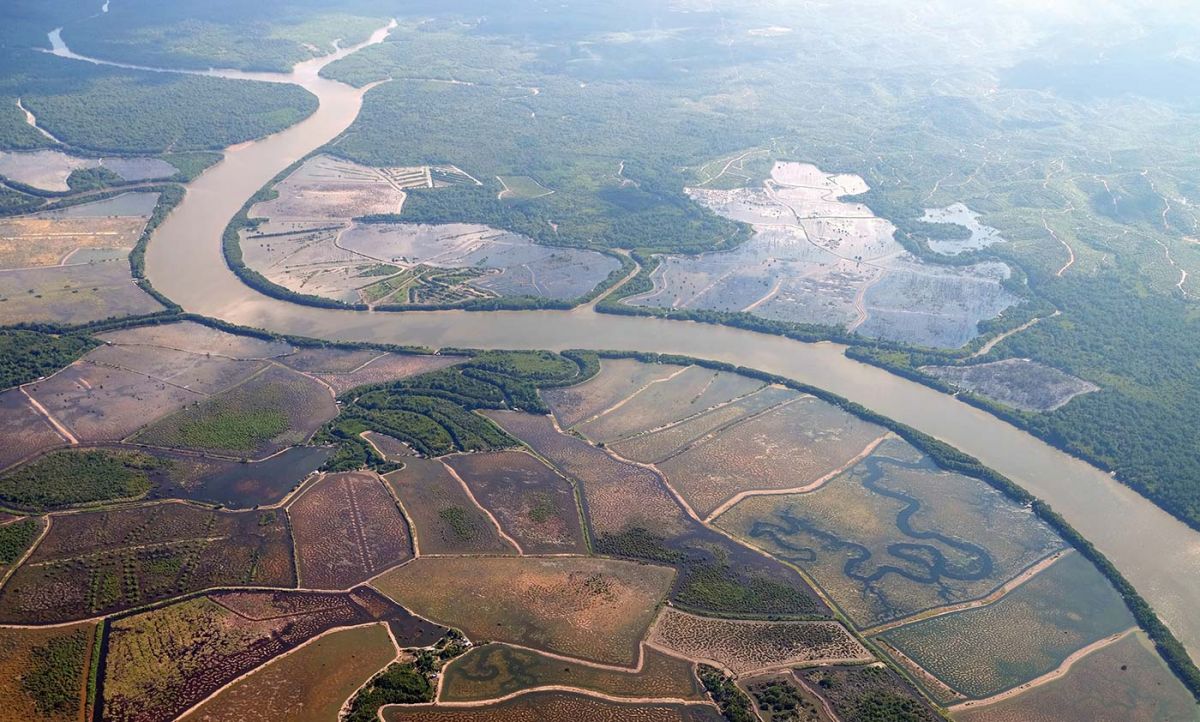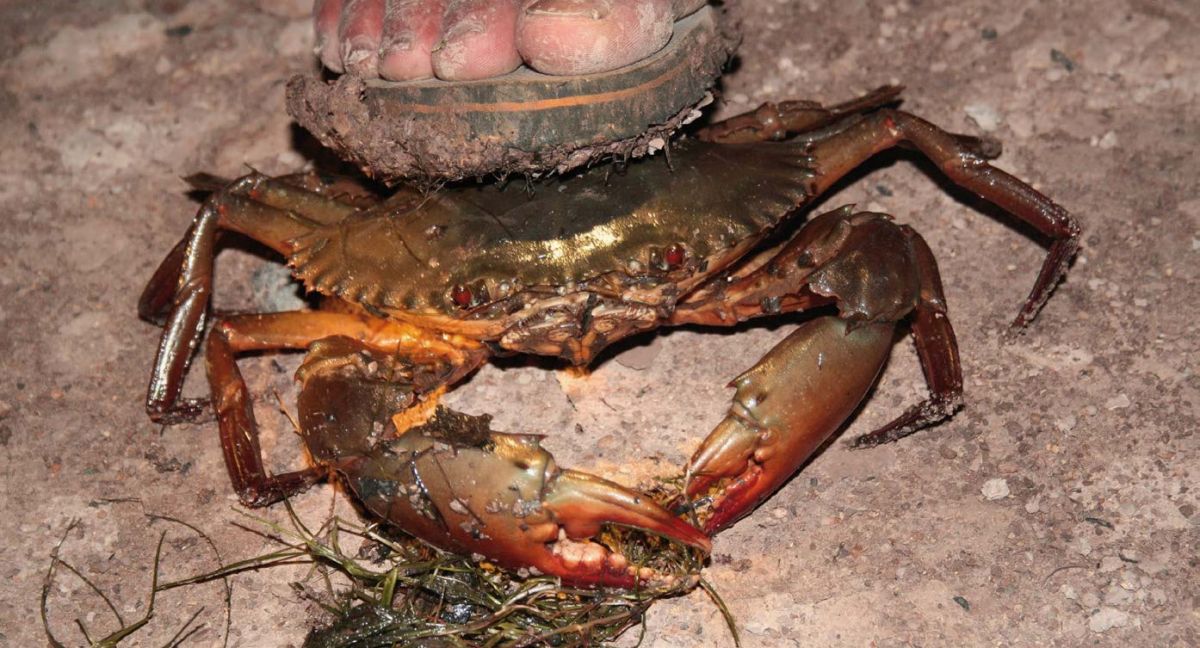Ruined pondscapes in North Kalimantan, Indonesia
The frontier of large-scale shrimp aquaculture arrived in North Kalimantan in the early 1990s, boomed during the Asian Financial crisis of 1998-1999 when the rupiah was weak, and expanded in the years afterwards. Since then things have changed, as ponds have started dying off. Today, as especially downriver ponds are abandoned, caretakers and businessmen find new ways to extract resources in the ruins, maintaining debt-based patronage relationships that often stretch back generations and span several waves of different resource frontiers and territorializations. Resource frontiers created tension and conflict over land, but so did the following ruination, and struggle for control over new resources.
Shrimp aquaculture is not the first resource frontier to wax and wane on the northeast coast of Borneo, what is now the Indonesian province of North Kalimantan, and it is not the first one to produce ruined, altered landscapes either. For hundreds if not thousands of years, commodities have been extracted, traded and shipped off from forests and coastal reefs, reaching distant destinations. Slaves, rattans, eaglewood and gold dust from land; holothurians and prized shells from the bottom of the sea. Each resource frontier produced its own ruined landscapes, and Tarakan, the city where I had based myself and my family during fieldwork, has grown and contracted accordingly. A hub for slave trade until oil was found, and for a period of time home to some of the richest oil wells in Indonesia. Today, the ruins of yesterday’s resource frontiers are an integrated part of everyday life of the city. The coral reefs have been dynamited, the seafloor scarred by trawl. Cows graze under rusty oil jacks, former sawmills have become storehouses while fishermen tether their boats at derelict gas rigs, protruding from the shallow brown water.
The infrastructure and ruins of today’s resource frontier, extensive shrimp aquaculture, is impossible to miss when arriving by plane. From the air, these pondscapes, mosaics of greens, browns and blues, have an eerie likeness to those cross sections of cells found in biology textbooks. In order to maximize the productive surface, ponds are shaped to fit each other, while following the twisting and curling streams they depend on for fresh water and for disposal of waste. Streams that run into rivulets, that run into rivers, that run into the sea during low tide, and reverse during high tide, create long stretches of labyrinthine brackish waterways. Once meandering freely through mangrove forests, the streams are now held in place by the floodgates, the dikes and the embankments characteristic of shrimp aquaculture; some abandoned ruins, others still producing.
On debt-based patronage
The political economies of the pondscapes follow a similar logic as the ever-branching rivers. Many thousand men are hired as caretakers, responsible for doing all the manual work. They are employed by thousands of owners, most of whom live in the city. The owners are indebted to a class of buyers, often called bos, who finance their ponds, the machinery needed, the shrimp fry, their nets, the ice, the gasoline. In turn, the bos will have exclusive rights to the catch – part of which he will take as repayment of the loan, part of which he will buy at a discounted rate. The bos himself is often indebted too, to richer men known as bos besar, who manage a portfolio of minor bos on behalf of cold storages, factories owned by Chinese or Japanese conglomerates, who ultimately buy, process, freeze and export all quality shrimp farmed in the area.
Towering above the seaside slum are enormous concrete mansions, dazzling in color and architectural eclecticism, indicative of where the successful bos live. Many of them are members of families who came to Tarakan alongside the Dutch, during the days when oil was the commodity. Sitting in the office of one such Bugis bos in Tarakan, I was guided through the paperwork necessary for making a new pond. Compared with the sheer amount of paperwork you normally need to do anything in Indonesia, this was nothing. “It is very simple. You go to the Tidung village who owns the land, and ask the leader [Kepala Desa], and pay him maybe 10 million to make you a claim letter. This gives you 10 ha for the pond, and you can get several if you want. This is what most people do [...] You don’t have to go to the government offices, only if you wish to get ownership, but this is expensive, it is not worth it”.[1] Asked why it is only Bugis who build and own ponds he said, “The Tidung are too lazy, they are too poor. They cannot afford the machines needed. They are fishermen and they work at our ponds, although I prefer family [here meaning other Bugis] as workers”.
Many Tidung disagree. One leader of a Tidung ethnic organization explained how the Bugis, through connections in the government, were systematically stealing their land. “They have people in all the offices and in the police. They are better educated. We need to be united against them to stand a chance”. Tension has erupted into violence from time to time. Tension between some Bugis groups and the now minority Tidung peaked in 2010, when a fight between youngsters resulted in a man being killed. Hours later, crowds from both groups assembled and clashed at several locations on the island, leaving at least seven people dead, while more than 40.000 fled their homes. Cautious national police blockaded the island for weeks, hoping to prevent the warring groups from obtaining outside assistance. The clashes escalated because of grievances between the opposing groups over access to land and lucrative government contracts.[2]
Anna Tsing uses the term ‘salvage accumulation’ to describe the processes through which capital is extracted from non-capitalist systems of production, such as the dispossession of the indigenous Tidung, and the debt relationships in which pond owners are forced to sell below market price to the bos, and buy household necessities from him on credit.[3] The supply-chains which connect the destitute worker squatting on the embankment of the pond with the consumer in the supermarket, is founded on such heterogeneities and even strengthens them.[4] The cold storages maintain the debt-networks, through providing capital for the bos class. They entertain special prices for the bos, with whom they have long relationships (in some cases, even prior to shrimp aquaculture), thereby enforcing the hereditary bos dynasties so visible in city geography.
Ruined pondscapes
In recent times, older ponds have started to fall into disuse, and are quickly deteriorating. The mud embankments that encircle them, once laboriously maintained by hard-working men, crumble and leak while the abandoned sheds that once held families are scavenged for building materials. The ponds themselves choke with fast-growing palms and the brightly-leafed saplings of mangrove trees sprout around the stumps of trees cut down years ago.
Around these ruins are clusters of ponds that are still maintained, restocked and harvested as in the old days, but production is erratic and harvests frequently fail. Sometimes failure can be predicted with the help of subtle signs, such as an overrepresentation of a certain kind of freshwater snail, too much or too little of a certain kind of algae; other times the signs are obvious even to the untrained eye: the water smells rotten, has an unusual color or might be covered by an oily film. But mostly, failure is not evident before the pond is emptied through a huge net into the river at low tide. Anticipation turns into disappointment in a matter of hours. These ponds are in a process of continual ruination that ties the choices of the past together with the possibilities of tomorrow.[5] Explanations for these failures vary. Most of the owners and caretakers I spoke with blame the expanding palm-oil plantations upstream. Their herbicides, pesticides and fertilizers foul the water, and the clearing of forests changes drainage dynamics, leading to surges of fresh water through the otherwise brackish river systems during heavy rainfall, which are deadly to the farmed shrimp. Others blame the upstream hydraulic mining, where riverbanks are washed away with high-pressure hoses, and mercury is used in the process of extracting the precious flakes of gold. But take a look at the shelves of any well-stocked pond owner and you will find a collection of products to match the chemical shelf of any plantation: pesticides, herbicides, antibiotics and an assortment of unlabeled powders and mixtures, all extensively used. Others again point to bacterial or viral epidemics that spread through the monocrop shrimp ponds, where the accumulated buildup of waste from billions of shrimp form a hotbed of infection, which easily spreads from pond to pond through the waterways connecting them all. Ruination is an active process co-created by many actors, human and non-human alike. It is not something than is solely thrust upon affected pond-owners from the outside, although that is what pond owners and workers will tell you.
Ruination leads to downriver ponds being abandoned every season. In the remaining ones, owners maintain production. Some because of sheer stubbornness, others because of mounting debts that desperately need repaying (by that windfall harvest that grows ever more unlikely as the ponds further deteriorate). For the owners of the ponds this is critical, as they repay their loans with the value of the catch. Caretakers, many of whom are landless immigrants from neighboring Sulawesi, are paid in percentages, and so failed harvests equal no pay.
Productive ruins
In the downriver patchwork of ruins and struggling ponds, all caretakers I met supplemented their income by collecting and selling mangrove crab, the common name for what is actually at least four different species (Scylla spp.) A prized delicacy, sold alive in the metropolises of Asia. Naturally occurring in the brackish waters of estuaries and mangroves in the Indo-Pacific, the crabs have adapted and proliferated in the pondscapes. The sheltered ponds, stocked with feed and free of some of their natural predators, are near perfect environments for the crabs, who can better tolerate variations in salinity, and levels of ammonia and oxygen than farmed shrimp can. They even thrive in some of the ruined ponds where the shrimp have died off from pollution. Productive ruins in ruins.
Mangrove crabs hide during the day in tunnels dug in the intertidal zone, and forage during night. In the wild, this helps soil aeration and increases soil turnover rate in the mangrove to the extent that biologists have labelled them ecosystem engineers. However, in the ponds the burrowing crabs undermine the embankments, leading to leaks and accelerating the ruination. Sometimes a serious leak caused by burrowing crabs will be the final straw if reconstruction of the embankment is unfeasible, and thus they are considered pests by pond owners. Maintaining embankments is backbreaking work, done with hoe and shovel; but repairing a collapsed embankment is expensive and requires heavy machinery, something the owner would consider twice in an already degraded pond. For the caretakers, however, the mangrove crabs constitute an opportunity for a relatively stable income; in struggling ponds the sale of crabs often exceeds the salaries they are paid by the owners, and in failed ponds crabs are their only source of revenue. At night when the crabs are active, caretakers don headlights and rubber boots, and stalk the pond embankments with large nets. The presence of ruined and abandoned ponds increases the area the caretaker can cover at night and the number of crabs he can catch. Among the overgrown ruins, however, one has to be careful. Not only crabs but saltwater crocodiles too are attracted by the abandoned ponds, only visited occasionally by a caretaker on the hunt for crab. Downstream the large majority of them are juvenile, but occasionally a caretaker goes missing, save for a foot or disgorged sandal. I am told, as long as you don’t swear or throw things at them, the ibu ibu [grandmothers], as they are called, will not attack you, but in the ruined landscapes you never know.
Several times a week, a speedboat with a collector of crabs will visit the caretaker’s shack, buying any live crabs he might have to offer. Collectors also peddle in everyday items such as cigarettes and instant noodles, and some in more clandestine wares such as methamphetamine, a relatively common drug among the young men working in the isolated ponds for months at a time. The countless rivers and streams, nooks and crannies of North Kalimantan, are some of the main entry points of Filipino and Cambodian drugs into Indonesia. Some collectors also bring crab larvae, which daring or desperate caretakers plant in the ponds, to further increase the number of crabs they can collect, to the benefit of both collector and caretaker. This is not without any risk though, as the crabs feed on the valuable shrimp larvae and their burrowing undermines the pond. If the owner learns of this practice, the caretaker in question will surely be fired.
Thus, the crabs thrive in pondscapes, even in those that are ruined and abandoned. But the crabs are also active co-creators of ruin, presenting opportunity in the ruins of monocrop pond aquaculture for the people working at the bottom of the supply chain. When the crab ends up on the plate in a Singaporean restaurant, it has become an object of luxury, of desire. Its past as a pest in a contaminated pond is forgotten and it is now used as treats for business contacts, officials or senior colleagues, people from whom you want favors. They are offered on big plates, whole in their carapaces. It is said that crabmeat is an aphrodisiac, and eating it definitely is a multi-sensory experience. Breaking the tough shell, dismantling the claws, sucking the meat and juice out of hard-to-get places, is a messy business. Both crab and shrimp are not only shredded from their carapaces when they reach their destinations. They are also shredded from the history, the ethnic conflict, the ruined landscapes and the unequal and destitute lives of the people handling them along the supply chain of luxury commodities. The cycle repeats itself, but the commodity changes according to taste and availability. Finding new objects of desire in the ruins of old extractions, retaining and solidifying systems of immense inequality that sometimes span centuries, but also presenting possibilities for the astute worker, and thus the cycle begins anew.
Thomas Mikkelsen, PhD Candidate, Aarhus University, Denmark
[1] Technically, this only gives three years of usage, until you apply for ownership with the district government, but in practice it lasts indefinitely. The man I spoke with had inherited 15 ponds from his father, who had migrated to Tarakan in the 1970s, and the sole document showing his ownership was a surat garapan for each.
[2] Wilson, C. 2013. ‘“Ethnic outbidding” for patronage: the 2010 riots in Tarakan, Indonesia’, South East Asia Research 21(1):105-129, doi:10.5367/sear.2013.0135
[3] Tsing, A. 2015. The mushroom at the end of the world : on the possibility of life in capitalist ruins. Princeton, New Jersey: Princeton University Press.
[4] Tsing, A. 2016. ‘What Is Emerging? Supply Chains and the Remaking of Asia’, The Professional Geographer 68(2):330-337, doi:10.1080/00330124.2015.1099186
[5] Paprocki, K. 2019. ‘All that is solid melts into the bay: Anticipatory ruination on Bangladesh's climate frontier’, in M. Eilenberg & J. Cons (eds) Frontier Assemblages: The emergent politics of resource frontiers in Asia. Wiley Blackwell, pp.25-39.


